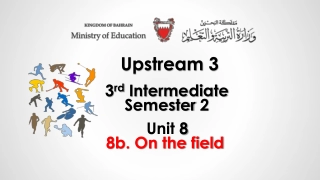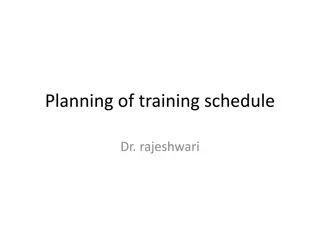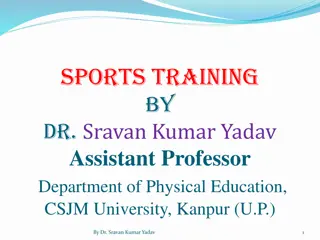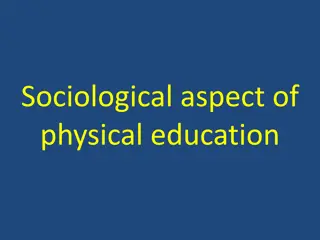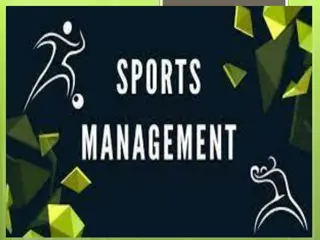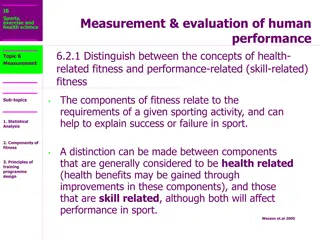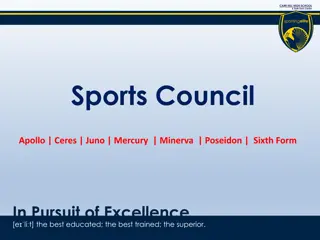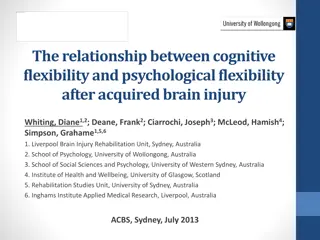Enhancing Sports Performance Through Psychological Skill Training
Sports psychology delves into the psychological factors affecting athletic performance, emphasizing the importance of Psychological Skills Training (PST) to equip athletes with mental skills tailored to their individual needs. These skills techniques help in enhancing self-confidence, goal-setting, stress management, imagery use, and concentration. Successful athletes possess nine key mental skills, yet psychological skills are often neglected due to lack of information, misunderstandings, and time constraints.
Download Presentation

Please find below an Image/Link to download the presentation.
The content on the website is provided AS IS for your information and personal use only. It may not be sold, licensed, or shared on other websites without obtaining consent from the author. Download presentation by click this link. If you encounter any issues during the download, it is possible that the publisher has removed the file from their server.
E N D
Presentation Transcript
Psychological Skill Training for Enhancing Sports Performance 1
SPORTS PSYCHOLOGY Sport psychology is the study of human behavior in sports. It analyses psychological factors that affect the performance of individuals and groups in sports. Sports psychology looks at helping athletes achieve peak performance. This is done by helping athletes gain equipping them with mental skills to both harness their strengths, as well as minimize the psychological effects of injury and poor performance self-awareness and 2
Psychological Skills Training(PST) Psychological Skills Training (PST) is an individually designed combination of methods selected psychological skill needs. There is no single tranquil PST package; each program must be individualized based on the psychological state of the individual as well as the sport. to attain
Skill Techniques Psychological skills techniques help athletes make adjustments to their actions, thoughts, feelings, and physical sensations that will improve their games. Players can use these techniques to help build self-confidence, set goals, manage their stress, use imagery and visualization to work on game skills, focus concentration and attention. 4
MENTAL SKILLS Mental athletes control their minds efficiently and consistently as they execute sport-related goals. This not only involves developing skills such as concentration and stress control, but it also includes efforts to influence personal characteristics such sportsmanship skills are procedures that help as self-esteem and 5
MENTAL SKILLS A Brief List of the Nine Mental Skills Successful Athletes: Choose and maintain a positive attitude. Maintain a high level of self-motivation. Set high, realistic goals. Deal effectively with people. Use positive self-talk. Use positive mental imagery. Manage anxiety effectively. Manage their emotions effectively. Maintain concentration. 6
Why Are Psychological Skills Neglected? Lack of informations (coaches and players) Misunderstandings about psychological skills (Eg. They can t be learned as they are not important ) Lack of time and excucess 7
PST Myths PST is for problem athletes only. PST is for elite athletes only. PST provides quick fix solutions PST is not useful. 8
The Performance Pyramid Although each of the nine skills is important, its primary importance will occur during one of three phases: long-term development, immediate preparation for performance, and during performance itself. Level I - These mental skills constitute a broad base for attaining long-term goals, learning, and sustaining daily practice. They are needed on a day-by-day basis for long periods of time, often months and years. Level II - These skills are used immediately before performance to prepare for performance. They maybe used just before competition begins, or immediately before a specific performance action, such as a golf shot or a free throw in basketball. Level III - These skills are used during actual performance behavior. 10
1. Attitude Successful athletes: Realize that attitude is a choice. Choose an attitude that is predominately positive. View their sport as an opportunity to compete against themselves and learn from their successes and failures. Maintain balance and perspective between their sport and the rest of their lives. Respect their sport, other participants, coaches, officials, and themselves. 12
2.Motivation Successful athletes: Are aware of the rewards and benefits that they expect to experience through their sports participation. Are able to persist through difficult tasks and difficult times, even when these rewards and benefits are not immediately forthcoming. Realize that many of the benefits come from their participation, not the outcome. 13
3. Goals and Commitment Successfulathletes: Set long-term and short-term goals that are realistic, measurable, and time-oriented. Are aware of their current performance levels and are able to develop specific, detailed plans for attaining their goals. Are highly committed to their goals and to carrying out the daily demands of their training programs. 14
TEN GOAL SETTING PRINCIPLES Set goals for mental as well as physical skills. Set goals that are specific and measurable. Set a target date for completion. Set goals that are difficult but realistic. Set short-term, intermediate, and long-term goals. Set goals for practice as well as for matches Set goals that are positive (like improving first serve percentage ) as opposed to negative (like allowing fewer aces ). Remain flexible enough to adjust goals as needed. Write the goals down on paper. Emphasize performance goals over outcome goals (such as winning). 15
4. People Skills Successfulathletes: Realize that they are part of a larger system that includes their families, friends, teammates, coaches, and others. When appropriate, communicate their thoughts, feelings, and needs to these people and listen to them as well. Have learned effective skills for dealing with conflict, difficult opponents, and other people when they are negative or oppositional. 16
5. Self-Talk Successful athletes: Maintain their self-confidence during difficult times with realistic, positive self-talk. Talk to themselves the way they would talk to their own best friend Use self-talk to regulate thoughts, feelings and behaviors during competition. 17
6. Mental Imagery Successful athletes: Prepare themselves for competition by imagining themselves performing well in competition. Create and use mental images that are detailed, specific, and realistic. Use imagery during competition to prepare for action and recover from errors and poor performances. 18
Imagery Categories The five main categories of imagery have been identified as follows: Motivational-specific (MS) - This involves seeing yourself winning an event, receiving a trophy or medal and being congratulated by other athletes. MS imagery may boost motivation and effort during training and facilitate goal- setting, but is unlikely on its own to lead directly to improved performance Motivational general-mastery (MG-M) - This is based on seeing yourself coping in difficult circumstances and mastering challenging situations. It might include maintaining a positive focus while behind, and then coming back to win. MG-M imagery appears to be important in developing expectations of success and self-confidence Motivational general-arousal (MG-A) - This is imagery that reflects feelings of relaxation, stress, anxiety or arousal in relation to sports competitions. There is good evidence to suggest that MG-A imagery can influence heart rate - one index of arousal - and can be employed as a 'psych-up'strategy Cognitive specific (CS) - This involves seeing yourself perform specific skills, such as a tennis serve, golf putt or triple-toe-loop in figure skating. If learning and performance are the desired outcomes, evidence suggests that CS imagery will be the most effective choice Cognitive general (CG) - This involves images of strategy and game plans related to a competitive event. Examples could include employing a serve-and- volley strategy in tennis or a quick-break play in basketball 19
FITT In designing your imagery program, apply the FITT principals, as we do with physical training F is for Frequency - Aim to incorporate imagery into every day of your training schedule. For busy people, just before you sleep could be a good time, and it helps if you are in a relaxed and tranquil state I is for Intensity - Try to create an all-sensory experience that is as vivid and clear as possible. Initially, practising in a quiet environment can help to minimise distractions and facilitate clear images T is for Time - Imagery should make big demands on your attention, so short (5-10 minutes) frequent quality sessions are preferable to long ones T is for Type - Remember to decide on your desired outcome and select the type of imagery to match it. 20
7. Dealing Effectively with Anxiety Successful athletes: Accept anxiety as part of sport. Realize that some degree of anxiet them perform well. Know how to reduce anxiety when it becomes too strong, without losing their intensity. y canhelp 21
8. Dealing Effectively with Emotions Successful athletes: Accept strong emotions such as excitement, anger, and disappointment as part of the sport experience. Are able to use these emotions to improve, rather than interfere with high level performance 22
9. Concentration Successful athletes: - is the mental quality to focus on the task in hand. If the athlete lacks concentration then their athletic abilities will not be effectively or efficiently applied to the task Know what they must pay attention to during each game or sport situation. Have learned how to maintain focus and resist distractions, whether they come from the environment or from within themselves. Are able to regain their focus when concentration is lost during competition. Have learned how to play in the here-and-now , without regard to either past or anticipated future events. 23
Various Concentrations Sustained concentration - distance runni cycling, tennis, squash ng , Short bursts of concentration - cricket, golf, shooting, athletic field events Intense concentration - sprinting events,, skiing 24
Confidence Confidence results from the comparison an athlete makes between the goal and their ability. The athlete will have self-confidence if they believe they can achieve their goal. (Comes back to a quote of mine - "You only achieve what you believe"). Good goal setting (challenging yet realistic) can bring feelings of success. If athletes can see that they are achieving their short term goals and moving towards their long term goals then confidence grows. 25
Commitment and Belief Commitment and belief allow you to excel or become the best you can possibly be in your chosen pursuit. Together they form the hub or heart of human excellence. These two basic elements of excellence encompass your overall perspective or orientation towards excellence, the way you view yourself, your capacity and the importance of your pursuit, and your desire to become your best. Your commitment or passion for your pursuit, your willingness to work hard and persist in the face of challenges and obstacles, and the extent to which you grow to believe in yourself and what you are doing are critical components of excellence. 26
Five elements The five remaining elements of excellence, presented as spokes on the Wheel of Excellence, are : Full Focus, Positive Images, Mental Readiness, Distraction Control, and Constructive Evaluation . These five spokes of excellence are mental skills that channel commitment and belief into a series of positive actions that make your performance wheel run smoothly and efficiently. 27


